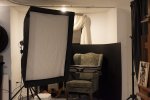The fact that the manufacturers don't use it as a selling feature is telling.
Dual gain requires there to be two connections from the sensor, ie additional analogue circuitry is added to accommodate greater amplification, a higher gain applied to the sensor signal. An added cost and complexity, especially in a small consumer camera like the DJI Hasselblad system.
Video is quite different than still, video is not multiple stills. There are lots of computation in video, including DLog capture thats not required in still capture. Even RAW capture in video is not multiple stills. Still capture works in RGB whereas video works in YCC (a detailed luminosity channel and two highly reduced colour channels) to minimize data size. Being technically oriented you will know that video capture takes clever advantage of the fact that our eyes are very sensitive to luminosity (gray scale) and quite insensitive to colour.
Camera manufacturers are very careful not to give away too much detail on how they handle the science but I believe for digital stills there are other ways to minimize digital noise and still maintain highlights and shadows throughout the ISO range.
In many respects a camera that shoots stills & video is like two different technology cameras packaged into one box. They share a lens, sensor, storage and display but thats about it.
You should be aware that "dual iso" is not a panercea, I haven't seen a DJI technical explanation but by pumping up the gain for high ISO you substantially clip highlights in order to get more shadow detail.In your setup you have to decide if highlights are important or shadows because if you move to the higher "native" gain (higher ISO) then you clip the capture and loose several stops of highlights.
I think the "dual native iso" in the
M3 is used in their new night mode, the reason being that the higher native ISO gives a lot more bandwidth (space below middle gray) in the shadows
One fact to remember, whether it's day or night, whether you set high ISO or low ISO, absolutely nothing changes from a capture point of view at the sensor. The sensor captures X amount of light regardless of ISO setting. If you work in RAW, the same image captured at night with high or low ISO, roughly speaking can be corrected in post and look similar. You either amplify the analogue signal from the sensor or you amplify the signal digitally in post, pretty much the same thing.












